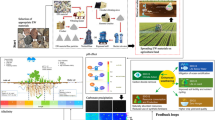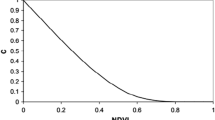Abstract
The available soil water capacity (ASWC) is important for studying crop production, agro-ecological zoning, irrigation planning, and land cover changes. Laboratory determined data of ASWC are often not available for most of soil profiles and the nationwide ASWC largely remains lacking in relevant soil data in China. This work was to estimate ASWC based on physical and chemical properties and analyze the spatial distribution of ASWC in China. The pedo-transfer functions (PTFs), derived from 220 survey data of ASWC, and the empirical data of ASWC based on soil texture were applied to quantify the ASWC. GIS technology was used to develop a spatial file of ASWC in China and the spatial distribution of ASWC was also analyzed. The results showed the value of ASWC ranges from 15 × 10−2 cm3·cm−3 to 22 × 10−2 cm3·cm−3 for most soil types, and few soil types are lower than 15 × 10−2 cm3·cm−3 or higher than 22 × 10−2 cm3·cm−3. The ASWC is different according to the complex soil types and their distribution. It is higher in the east than that in the west, and the values reduce from south to north except the northeastern part of China. The ‘high’ values of ASWC appear in southeast, northeastern mountain regions and Northeast China Plain. The relatively ‘high‘ values of ASWC appear in Sichuan basin, Huang-Huai-Hai plain and the east of Inner Mongolia. The relatively ‘low’ values are distributed in the west and the Loess Plateau of China. The ‘very low’ value regions are the northern Tibetan Plateau and the desertified areas in northern China. In some regions, the ASWC changes according to the complex topography and different types of soils. Though there remains precision limitation, the spatial data of ASWC derived from this study are improved on current data files of soil water retention properties for Chinese soils. This study presents basic data and analysis methods for estimation and evaluation of ASWC in China.
Similar content being viewed by others
References
Aina P O, S P Periaswami, 1985. Estimating available water-holding capacity of western Nigerian soils from soil texture and bulk density, using core and sieved samples.Soil Sci., 140(1): 55–58.
Batjes N H, 1996. Development of a world data set of soil water retention properties using pedotransfer rules.Geoderma, 71(1): 31–52.
Bill Krueger. Water Budget Irrigation Scheduling. ORCHARD FACTS. April 10, 2000. vol. II, No.8. http://ucanr.org/common/searcher.cfm
Bregt A K, Beemster J G H, 1989. Accuracy in predicting moisture deficits and changes in yield from soil maps.Geoderma, 43(4): 301–310.
Cassel D K, L F Ratliff, J T Ritchie, 1983. Models for estimating in-situ potential extractable water using soil physical and chemical properties.Soil Sci. Soc. Am. J., 47(4): 764–769.
Commission for Integrated Survey of Natural Resources, 1990. Handbook of Natural Resources in China. Beijing: Science Press, 62–63. (in Chinese)
De Jong R, Shields J A, Sly W K, 1984. Estimated soil water reserves applicable to a wheat-fallow rotation for generalized soil areas mapped in southern Saskatchewan.Can. J. Soil Sci., 64(3): 667–680.
Doorenbos J, Kassam A H, 1978. Yield response to water. Irrigation and Drainage, FAO, Rome, 33.
Gao Y X, Li J, Zhou M Cet al., 1998. Soil Map of China (1:4,000,000). Beijing: Science Press.
Israelson O W, Hansen V E, 1962. Irrigation Principles and Practices. 3rd edn. New York: Wiley, 62.
Kern J S, 1995a. Geographic patterns of soil-water holding capacity in the contiguous United States.Soil Sci. Soc. Am. J., 59(4): 1126–1133.
Kern J S, 1995b. Evaluation of soil water retention models based on basic soil physical properties.Soil Sci. Soc. J., 59(4): 1134–1141.
Lao Jiasheng, 1988. The Manual of Soil Agri-chemistry Analysis. Beijing: Chinese Agriculture Press, 208–228. (in Chinese)
Liu C M, Wang H X, 1999. The Interface Water Process of Soil-Plant-Air Integrated System and Control for Water Saving. Beijing: Science Press, 101–103. (in Chinese)
Luyten J C, 1995. Sustainable world food production and environment. Report 37, Research Institute for Agrobiology and Soil Fertility (AB-DLO), Wageningen.
Madsen H B, Holst K A, Mikkelsen S A, 1989. The use of the EC soil map in modelling and mapping the root zone capacity and irrigation need: a case study from Denmark. In: R J A Jones, B Biagi (eds.), Agriculture: Computerization of Land Use Data. Commission of the European Communities, Luxembourg, 74–84.
National Soil Survey Office, 1998. Chinese Soils. Beijing: Chinese Agriculture Press, 72; 843–859. (in Chinese)
Nettleton W D, B R Brasher, 1983. Correlation of clay minerals and properties of soils in the western United States.Soil Sci. Soc. Am. J., 47(5): 1032–1036.
Petersen G W, R L Cunningham, R P Matelski, 1968. Moisture characteristics of Pennsylvania soils: I. moisture retention as related to texture.Soil Sci. Soc. Am. Proc., 32(2): 271–275.
Rawls W L, Brakensiek D L, Saxton K E, 1982. Estimation of soil water properties.Trans. ASAE, 25(5): 1316–1320.
Reinds G J, De Koning G H J, Bulens J D, 1992. Crop production potential of rural area within the European Communities (Part III): soils, climate and administrative regions. Working Document 67, Netherlands Scientific Council for Government Policy, The Hague.
Rivers E D, R F Shipp, 1972. Available water capacity of sandy and gravelly North Dakota soils.Soil Sci., 113(2): 74–80.
Saxton K E, Rawls W J, Romberger J Set al., 1986. Estimating generalized soil-water characteristics from texture.Soil Sci. Soc. Am. J., 50(4): 1031–1036.
Scotter D R, 1981. Field capacity of water and soil available water.Soil Sci. Soc. Am. J., 45(5): 852–855.
Soil Resources, Management and Conservation Service, Land and Water Development Division, 1979. Soil Survey investigations for irrigation. In: FAO Soils Bulletin, Volume 42. Food and Agriculture Organization of the United Nations, Rome, 47–52.
USDA, 1998. Assessment of Water Holding Capacity of Soils. http://www.nrcs.usda.gov/technical/worldsoils/ mapindex/whc.html. (Updated on September 8, 2003).
Vereecken H, Maes J, Feyen Jet al., 1989. Estimating the soil moisture retention characteristic from texture, bulk density, and carbon content.Soil Sci., 148(5): 389–403.
Vogel A W, 1994. Compatibility of soil analytical data: determinations of cation exchange capacity, organic carbon, soil reaction, bulk density, and volume percent of water at selected pF values by different methods. Working Paper and Preprint 94/07, ISRIC, Wageningen.
Zheng Daolan, Hunt E R, Running S W, 1996. Comparison of available soil water capacity estimated from topography and soil series information.Landscape Ecology, 11(1): 3–14.
Zuidema G, Van den Born G J, Alcamo Jet al., 1994. Simulation of global land cover changes as affected by economic factors and climate.Water, Air, and Soil Pollut., 76(1–2): 163–198.
Author information
Authors and Affiliations
Corresponding author
Additional information
Foundation: National Natural Science Foundation of China, No.43071093
Author: Zhou Wenzuo (1972–), Ph.D. candidate, specialized in the study on the application of remote sensing and geographic information systems to regional sustainable development.
Rights and permissions
About this article
Cite this article
Zhou, W., Liu, G., Pan, J. et al. Distribution of available soil water capacity in China. J. Geogr. Sci. 15, 3–12 (2005). https://doi.org/10.1007/BF02873101
Received:
Accepted:
Issue Date:
DOI: https://doi.org/10.1007/BF02873101




